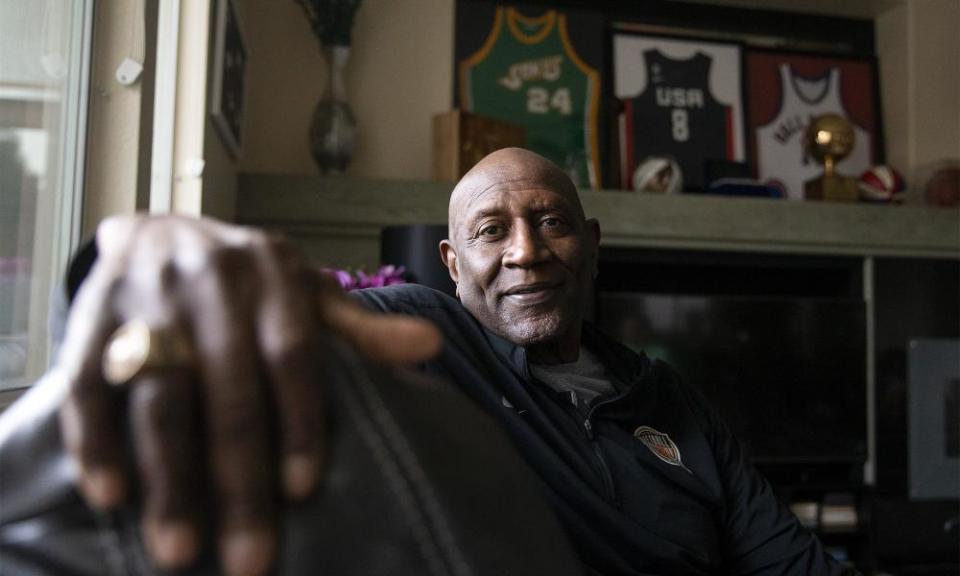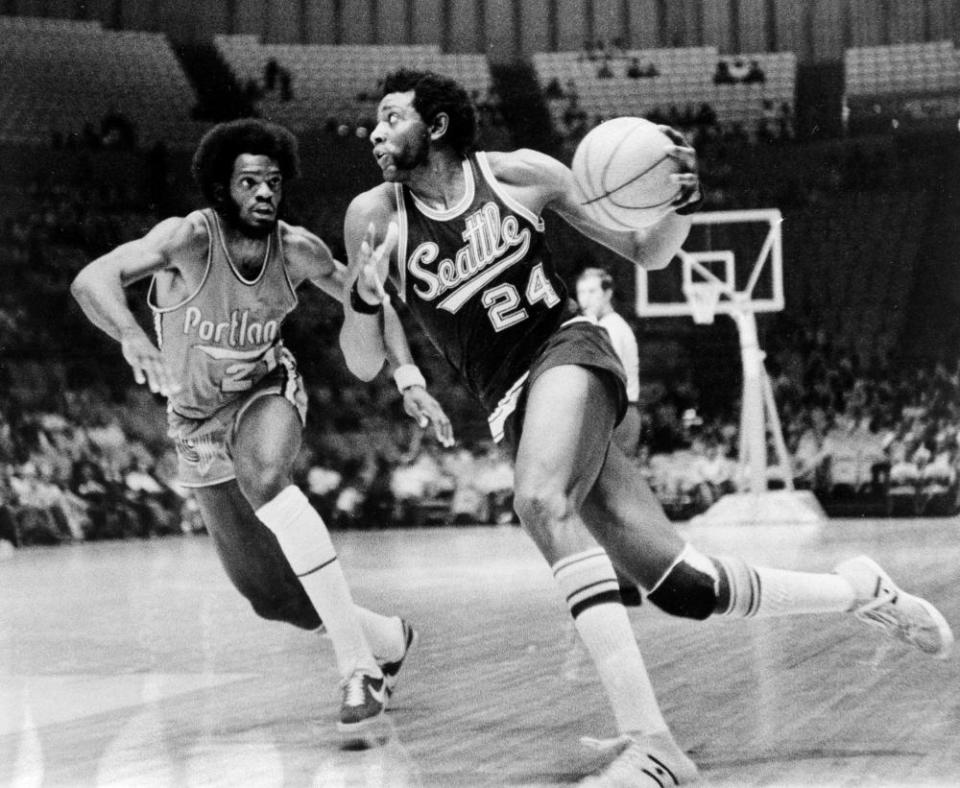Spencer Haywood: the NBA star who opened the door for generations of prodigies

Spencer Haywood was standing in the Cincinnati snow, freezing his butt off. The stylish green and gold bellbottom Seattle SuperSonics warmups he wore did little for the cold wind, which would blow up the thighs thanks to the wide ankle hem. The short-sleeve top didn’t help much, either. The 1970s had just begun but Haywood’s career, remarkable as it was, as a former ABA Rookie of the Year and MVP, had stalled again. But for the future multi-time All-Star, who later dealt with substance abuse issues while in the NBA with the Los Angeles Lakers, he wasn’t standing in the sub-freezing night because of any personal or professional infraction. No, he was in the process of changing the league forever. As such, he wasn’t even allowed to stand on the Cincinnati Royals court, opposite Tiny Archibald and Norm Van Lier, or go back into the locker room and get his street clothes. He was an “illegal player” and banned from the game before it started because, simply, he was in court fighting a bigger battle.
“‘We’ve got an illegal player on the floor,’ blah-blah-blah,” Haywood tells the Guardian, remembering back to his first year in the NBA with the SuperSonics. “There was another injunction against me. So, they put me out into the snow.”
Haywood, who in 1970 was the plaintiff in the now-famous Haywood v National Basketball Association court case, was pulled from the contest against Cincinnati while still in warmups. It was something of a sad, yet common occurrence for the 6ft 8in big man at the time. Start, stop, start stop. Play a handful of games, then get pulled. Why? Because he had the gall to leave the collegiate ranks after just two years. Haywood, who grew up in tiny Silver City, Mississippi, picking cotton for $2 a day, a life he likens to “slavery”, lived poor in a modest home with his family, sharing a bed with his brother – Haywood once went weeks without talking to his brother, despite sharing the bed, after a particularly contentious basketball game – and often enduring humiliating events thanks to the Jim Crow American south.
In high school, Haywood moved to Detroit, where he won a state championship at Pershing. After dominating his freshman year at Trinidad State junior college in Colorado, averaging 28.2 points and 22.1 rebounds, he made the 1968 US Olympic basketball team, where he led the squad to a gold medal over Russia in Mexico City – the same Games where track stars Tommie Smith and John Carlos raised their powerful, rebellious fists. He was the youngest ever to make the Olympic basketball team and he led it in scoring. He wept on the podium. The next year, not far from where he went to high school at the University of Detroit, recruited there by Michigan governor George Romney, Haywood led the country in rebounding at 21.5 per game and averaged 32.1 points.
Back in Mississippi, his mother made sharecropper’s wages in a region that often treated Blacks as subhuman. But according to the NCAA rules, Haywood was obliged to keep playing for free for two more seasons before turning pro. That’s when the upstart ABA stepped in, seeking to court Haywood – and when his life changed forever. The American Basketball Association’s Mike Storen and Haywood came up with the idea of the “hardship” clause. At the time, the ABA and NBA were in competition (before the ABA would fold a few years later). But one way the fledgling ABA sought to compete with the bigger NBA was by allowing college players to enter their ranks earlier than their senior counterpart. If a player came from poverty, as Haywood did, he’d be allowed to enter early. The ABA saw their chance with Haywood, and he saw his to earn a living. So, he was drafted.
In his first year with Denver, Haywood led the league with 30 points, 19.5 rebounds and 45.3 minutes played, in 84 games. He averaged 36.7 points and 19.8 rebounds in the playoffs that season, too, winning MVP and Rookie of the Year honors. But there was a problem. The ABA was financially unstable. He needed to be in the NBA if he wanted to make real money.
“I would get paid $400,000 for playing six years, or whatever the years were,” says Haywood of his ABA contract. “And the rest of the money was deferred, and I wouldn’t be able to receive it until I was age 50. And even then there was a provision that I had to still be working for the Ringsby Truck Line.”
It was 1968 when the Seattle SuperSonics came into existence. Two years later, when Haywood was leaving the ABA in 1970, the Sonics needed a big name to fill seats. So, the team’s owner Sam Schulman decided to try to get Haywood in Seattle. With the reigning ABA MVP onboard, Schulman filed an antitrust lawsuit against the NBA to create a hardship clause like the ABA’s, which would allow Haywood to play for his Sonics. The case rose to the US supreme court and, during Haywood’s first year in the NBA, which included just 33 games played and averages of 20.6 points and 12 rebounds, he was pulled in and out of lineups, called at times an illegal player and even had to stand in that snow in Cincinnati, forbidden to enter the Royals’ NBA gym. He was also told his case would ruin college basketball and bring immature players into the league. He was positioned by the NBA as someone who was taking the jobs from veterans.
“[Sam said], ‘Are you up for it? Are you ready for it?’ And I said I was born for this,” says Haywood. “I’m out of the cotton field.”
That first NBA season, Haywood played in a string of games, then he was banned from others due to various injunctions –all while his case was heard by the highest court in the land. When he was banned, he would work out with a Sonics ball boy–none other than Rick Welts, a future executive with the current champion Golden State Warriors. During downtime, they’d travel to nearby college campuses to talk to co-eds.
But when the supreme court made its ruling, Haywood had won. He was now free to enter the NBA permanently, as were other future hardship cases. If men were allowed to fight in Vietnam, the court ruled, they could play pro basketball. Schulman had stuck with Haywood all the way through, showing loyalty and paying the nearly $2m in legal fees. Now their efforts would pay off on the hardwood. For the next four years, Haywood was an All-Star and All-NBA player for Seattle, averaging 25.4 points, 12.1 rebounds and playing in nearly 300 games. The team would later retire his jersey.

Haywood loved his time in the Emerald City. Socially, it was light years from Mississippi (a region he’s helping recover today). He calls it “the most liberal city in the world” and a “utopia” when he was there. He played under Bill Russell, who years prior held the first integrated kids’ basketball camp in Mississippi, and player-coach Lenny Wilkens. He was there when the team made its first trip to the playoffs. He remembers eating Crab Louie at the local restaurant 13 Coins. Reflecting on all this, as Haywood does at times, especially nowadays as he works on a new biopic feature film about his life, he feels overwhelmed. But while Haywood has led a Forrest Gump-like story, one that has touched myriad moments in history, his victory over the NBA is where his impact is felt most. Though, he rarely seems to get the credit for those achievements. The undergraduate players succeeding during March Madness contemplating their futures, the straight-from-high school players and those known as one-and-done – Haywood’s name is likely not quick to their tongues, despite the fact he’s helped so many earn so much.
“It has made [the NBA players] over $35bn in salaries alone,” he says of his victory in court. “It has made the owners over $50bn in revenue, because they were able to expand from 15 teams at the time. And grow.”
Haywood wonders if LeBron James would have passed Kareem Abdul-Jabbar in the NBA’s all-time scoring rankings if he’d had to play in college four years before becoming a rookie. What would his career earnings be with four fewer years of professional service? And what about the European players like Luka Doncic, who don’t need any NCAA experience or number of years out of high school to play in the league? Haywood’s legacy is still felt in the NCAA ranks, too. When the recent Name, Image and Likeness rules were created to allow players in college to make money, his Supreme Court victory was again cited. Now college athletes can make suitable livings from their on-field labor before making the NBA, MLB or NFL.
“That was my argument,” says Haywood. “I couldn’t get any help for my mother and my family, who were picking cotton for $2 a day in Silver City, Mississippi.”
But over the years, Haywood’s win has caused him some professional scars. Not only was he cast as a villain during his early playing days, but it took him over a quarter-century to be inducted into the Naismith Basketball Hall of Fame, despite being an ABA MVP and four-time NBA All-Star. It was only after Charles Barkley spoke out saying the Hall would be incomplete without Haywood that he was finally welcomed in 2015. However, he was not included as part of the league’s recent Top 75 team. In more recent years, Haywood, a father of four daughters and who was married to the fashion model Iman for a decade, has been fighting for retired players in both the ABA and NBA to get health benefits and pensions. He’s a former chairman of the National Basketball Retired Players Association and he’s still winning battles on behalf of the basketball workforce. Now, he’s doing the same for retired WNBA players, too.
He takes pride in remembering the generations that came before. Similarly, Haywood, who lives in Las Vegas and has been doing college basketball broadcasting for March Madness of late, hopes people remember his name, his legacy. The 73-year-old Haywood jokes that he’s keeping himself in good shape – even eating vegan –for the day he might overhear a college star or young NBA standout thank him for the opportunity he helped create, the door he helped open. Haywood, who recently published a detailed memoir, The Spencer Haywood Rule, hopes he’s known for that very phrase in perpetuity.
“You can’t keep suppressing history,” Haywood says. “Otherwise, you’ll start living like Ron DeSantis.”

